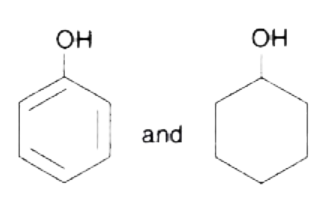Give one test each to distinguish between the following pairs of chemicals :
Iron (III) chloride solution and copper chloride solution.
To distinguish between Iron (III) chloride solution and Copper chloride solution, we can perform the following test using sodium hydroxide (NaOH):
1. Prepare the Solutions: Take two separate test tubes. In one test tube, add a few drops of Iron (III) chloride solution (FeCl3). In the other test tube, add a few drops of Copper chloride solution (CuCl2).
2. Add Sodium Hydroxide: To both test tubes, slowly add sodium hydroxide solution (NaOH) drop by drop while stirring gently.
3. Observe the Reactions:
- Iron (III) Chloride Reaction: When NaOH is added to the Iron (III) chloride solution, a reddish-brown precipitate of ferric hydroxide (Fe(OH)3) will form. The reaction can be represented as:
FeCl3+3NaOH→Fe(OH)3↓+3NaCl
- Copper Chloride Reaction: When NaOH is added to the Copper chloride solution, a pale blue precipitate of copper hydroxide (Cu(OH)2) will form. The reaction can be represented as:
CuCl2+2NaOH→Cu(OH)2↓+2NaCl
4. Conclusion: The formation of a reddish-brown precipitate indicates the presence of Iron (III) chloride, while the formation of a pale blue precipitate indicates the presence of Copper chloride. Thus, you can distinguish between the two solutions based on the color of the precipitate formed.
Summary of the Test:
- Iron (III) chloride solution: Reddish-brown precipitate of ferric hydroxide.
- Copper chloride solution: Pale blue precipitate of copper hydroxide.
- Iron (III) Chloride Reaction: When NaOH is added to the Iron (III) chloride solution, a reddish-brown precipitate of ferric hydroxide (Fe(OH)3) will form. The reaction can be represented as:
FeCl3+3NaOH→Fe(OH)3↓+3NaCl
- Copper Chloride Reaction: When NaOH is added to the Copper chloride solution, a pale blue precipitate of copper hydroxide (Cu(OH)2) will form. The reaction can be represented as:
CuCl2+2NaOH→Cu(OH)2↓+2NaCl
- Iron (III) chloride solution: Reddish-brown precipitate of ferric hydroxide.
- Copper chloride solution: Pale blue precipitate of copper hydroxide.
Topper's Solved these Questions
- ANALYTICAL CHEMISTRY- USE OF AMMONIUM HYDROXIDE AND SODIUM HYDROXIDEBOOK - ICSECHAPTER - ANALYTICAL CHEMISTRY- USE OF AMMONIUM HYDROXIDE AND SODIUM HYDROXIDEEXERCISE - Additional Questions for Practice
51 Videos
- ANALYTICAL CHEMISTRYBOOK - ICSECHAPTER - ANALYTICAL CHEMISTRYEXERCISE - Figure Based Questions
2 Videos
- ANALYTICAL CHEMISTRY-USE OF AMMONIUM & SODIUM HYDROXIDEBOOK - ICSECHAPTER - ANALYTICAL CHEMISTRY-USE OF AMMONIUM & SODIUM HYDROXIDEEXERCISE - Additional Questions
6 Videos
Similar Questions
Give one test each to distinguish between the following pairs of chemicals :
Sodium nitrate solution and sodium chloride solution.
View SolutionGive chemical test to distinguish between

View SolutionGive one chemical test to distinguish between the following pairs of compounds.
Iron (II) chloride solution and Iron (III) chloride solution.
View SolutionGive a chemical test to distinguish between the following pairs of compounds:

View SolutionGive one test each to distinguish between the following pairs of chemicals :
Zinc nitrate solution and calcium nitrate solution.
View SolutionGive a chemical test to distinguish between the following pairs of chemicals:
Sodium chloride solution and Sodium nitrate solution.
View SolutionGive one chemical test to distinguish between the following pairs of compounds.
Calcium nitrate solution and Calcium chloride solution.
View SolutionGive a chemical test to distinguish between the following pairs of chemicals:
Lead nitrate solution and Zinc nitrate solution
View SolutionGive one chemical test to distinguish between the following pairs of compounds.
Zinc sulphate solution and Zinc chloride solution.
View SolutionGive one chemical test each to distinguish between the following pairs of compounds : Propanal and Propanone.
View Solution
